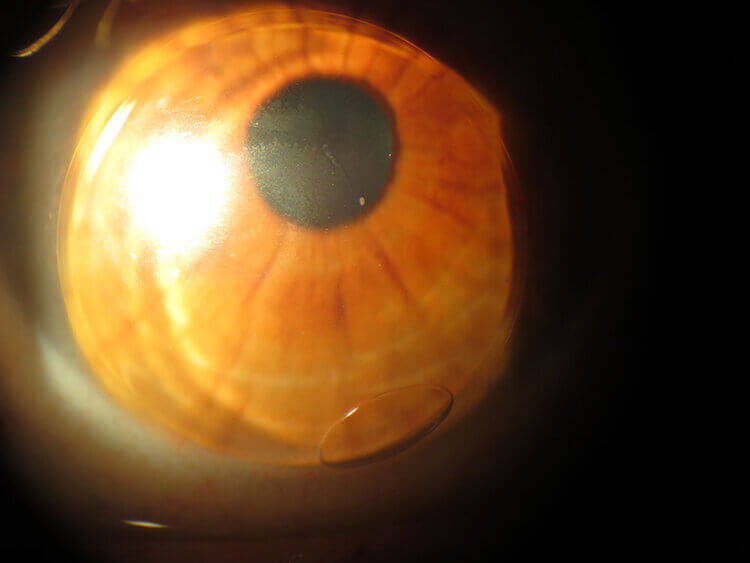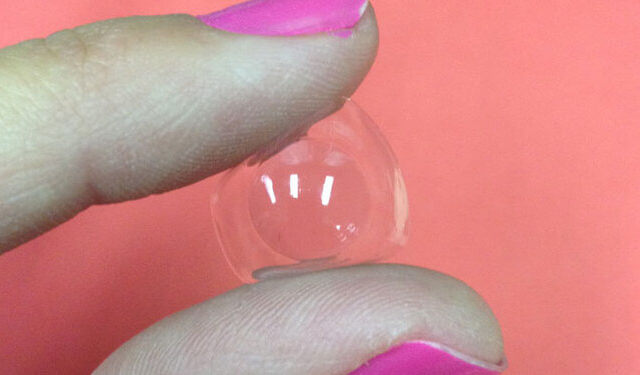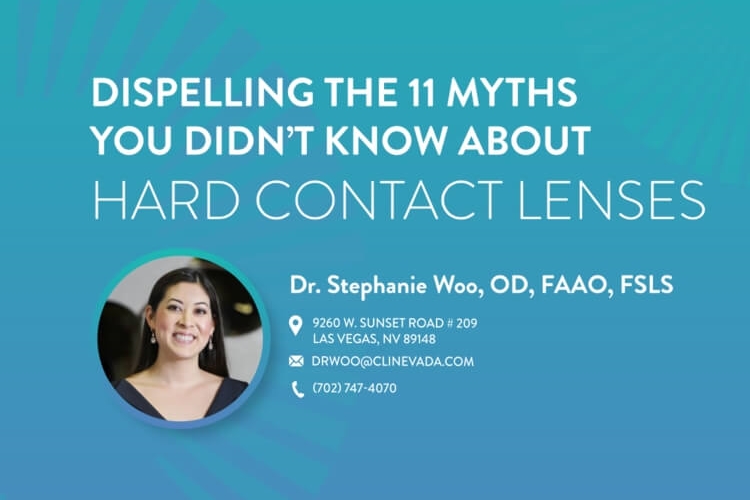What is a hybrid contact lens?
A hybrid contact lens is essentially the result of the combination of a conventional soft contact lens and a gas permeable lens. Due to the presence of both materials, a patient using a hybrid contact lens can reap the benefits of crisp vision provided by gas permeable lenses with the comfort of a soft contact lens. The center of the lens is made of a gas permeable lens and is surrounded by a soft silicone hydrogel contact lens skirt. This type of lens is available to any patient but may be especially beneficial to certain populations. This may include patients with high amounts of astigmatism or patients with irregular corneas as a result of corneal disease or surgery. The center of the lens provides sharp precise vision due to the more rigid material of the lens. The soft skirt anchors the contact lens in place on the eye to provide stable vision and increase overall comfort. The lens is inserted and removed daily. However, they differ from traditional soft contacts in that they are replaced less frequently. Hybrid lenses typically last up to 6 months. Therefore, their longer replacement schedules can make them more cost effective over time. Hybrid lenses can be beneficial for many patients. Speak to your eye doctor to discuss all your lens options and see if this is the right fit for you.
Who can use a hybrid contact lens?
Any patient can wear hybrid contact lenses. However, it may be beneficial in patients with irregular corneas or with high amounts of astigmatism. If you’ve been told in the past that you are not a contact lens candidate this may be an option for you! Since many patients who benefit from hybrid lenses have irregular corneas from surgery or corneal disease, hybrid lenses are another alternative to scleral contact lenses. Patients who are candidates for scleral contact lenses are therefore also candidates for hybrid lenses. Some patients prefer hybrid lenses over sclerals due to the ease of insertion and removal. Hybrid lenses are inserted and removed in a similar fashion to conventional soft contact lenses. In comparison, scleral lenses often require a little more practice in the insertion and removal due to the use of plungers. Patients with high astigmatism often have trouble achieving crisp vision in traditional soft lenses and benefit greatly from the optics offered in hybrids.
In summary, patients with a high rate of success with hybrid contact lenses include:
- Patients with high corneal astigmatism
- Patients that complain of discomfort with gas permeable lenses but prefer the quality of vision of these lenses
- Patients with excessive lens movement while using toric soft contact lenses (for astigmatism)
- Patients with irregular corneas and are interested in their options –ex: keratoconus patients
- Patients with presbyopia (trouble with near vision as you age) but don’t want bifocal glasses or progressive glasses
- Patients with corneal scarring or trauma
- Patients with a history of a corneal transplant
- Soft multifocal patients looking for crisper vision

What hybrid contact lenses are available?
Synergeyes is the only company that produces hybrid lenses currently. They have come out with two hybrid families: Duette and UltraHealth. The Duette line includes Duette HD, Duette Progressive, and the Duette Multi-focal. The UltraHealth lens includes the UltraHealth and UltraHealth FC. The UltraHealth line was designed to fit irregular corneas such as that from keratoconus or previous refractive surgery. The Duette line is engineered for regular corneas with astigmatism or for presbyopic patients that require both a reading power and a distance power simultaneously. Your eye doctor can determine which lens is right for you.
What is the difference between hybrid contact lenses and scleral contact lenses?
Scleral contact lenses are much larger than hybrid lenses. Both hybrids and sclerals vault over the cornea. However, scleral lenses are made entirely of a gas permeable material. Hybrid lenses are made of both silicone hydrogel and gas permeable materials. Tear circulation is minimized in scleral lenses due to the structure of the lens. Hybrid lenses offer more tear circulation as the soft contact lens skirt allows for circulation under. Both lenses offer good optics and comfort. Scleral lenses may be associated with slightly more initial lens awareness due to the large diameter. Some patients find sclerals difficult to insert due to a larger diameter lens as well. There is a different application and removal process for scleral lenses due to the need for a tear reservoir between the scleral lens and the eye.

What is the difference between a GP lens and a hybrid lens?
GP lenses are often smaller diameter lenses that provide good optics. These lenses can be fit for patients with corneal conditions such as keratoconus to provide sufficient vision correction. A gas permeable lens is the answer for patients who can’t achieve adequate crisp vision in a conventional soft contact lens. However, this lens is associated with lens awareness that often causes patients discomfort. A hybrid lens provides all the same benefits of a gas permeable lens, but offers a comfortable fit as well. The comfort is provided by a surrounding soft contact lens skirt that prevents excessive lens movement and edge awareness. The skirt helps prevent debris from lodging underneath the lens. It helps prevent the lens from dislodging from the eye during sports as well.
Frequently asked questions about hybrid lenses
-
Can I swim in these contacts?
o It is never recommended to swim in any form of a contact lens. If you must, it is suggested to wear goggles and to disinfect or replace the lens directly afterward. Swimming in fresh water with contacts on can increase your risk of infection from microbes such as acanthamoeba. This can result in severe pain and permanent vision loss.
-
How often do these lenses need to be replaced?
o Hybrid contact lenses should be replaced around the 6 month mark. This is a longer replacement schedule than conventional soft contact lenses, making hybrid lenses comparatively cost effective in the long run.
-
What are abnormal symptoms I should look out for?
o If you experience any discomfort, pain, blurry vision, light sensitivity, or persistent redness, discontinue lens use immediately. See your eye doctor to ensure you preserve your vision and treat any infections.
-
Can I sleep in my contact lenses?
o Hybrid lenses should be removed before sleeping to avoid eye infections and promote good eye health.
-
How do I clean hybrid lenses?
o Daily cleaning is important in maintaining proper lens hygiene. Place the lens bowl side up in the palm of your hand. Rinse your lenses with a daily cleaner that is approved for the lenses. Don’t use tap water to clean or store the lenses. Rub the lenses in a circular motion with your ring finger. Clean both the front and back surface of the lens. Store lenses in a hydrogen peroxide solution OR in a multi purpose disinfecting solution.
-
What is this white ring I see on the lens after cleaning?
o In some patients, the hydrogen peroxide in the lens cleaner may react to the chemistry of the teras to produce a white ring. This white ring is typically seen at the junction between the gas permeable center and the soft skirt. The ring will not affect your vision or comfort. The lenses could be used with the white ring present.

